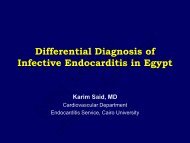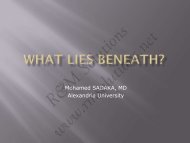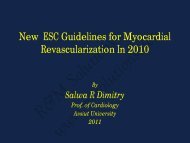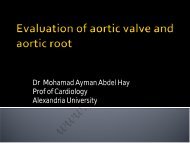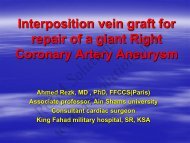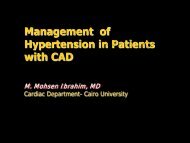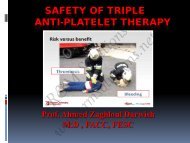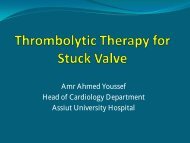QRS amplitude - cardioegypt2011
QRS amplitude - cardioegypt2011
QRS amplitude - cardioegypt2011
You also want an ePaper? Increase the reach of your titles
YUMPU automatically turns print PDFs into web optimized ePapers that Google loves.
R&M Solutions<br />
www.rmsolutions.net
ECG Criteria of VT Diagnosis !!<br />
By<br />
Said Fawzy, MD Cardiology<br />
Banha University<br />
R&M Solutions<br />
www.rmsolutions.net
Disclosures<br />
None<br />
R&M Solutions<br />
www.rmsolutions.net
What do I want from an ECG<br />
with suspected VT ?<br />
Tell me 1 st , who are you ?<br />
R&M Solutions<br />
www.rmsolutions.net
R&M Solutions<br />
www.rmsolutions.net
GP >> some PVCs (Bigeminy)<br />
R&M Solutions<br />
www.rmsolutions.net
Cardiologist ( c/p , number ,drugs)<br />
R&M Solutions<br />
www.rmsolutions.net
Electrophysiologists<br />
R&M Solutions<br />
www.rmsolutions.net
Another example<br />
R&M Solutions<br />
www.rmsolutions.net
What can, and what can't ECG tell us ?<br />
o VT or not .<br />
o An idea about the mechanism ,and<br />
possible underlying pathology.<br />
o Localize or at least regionalize the focus<br />
or the circuit.<br />
o Guide our strategy of treatment<br />
o Guide our mapping and ablation<br />
technique.<br />
o Epicardial or Endocardial origin<br />
R&M Solutions<br />
www.rmsolutions.net
VT or not ?<br />
R&M Solutions<br />
www.rmsolutions.net
Causes of WCT<br />
o VT is the most common cause of WCT (70-<br />
80%)<br />
o SVT with BBB ( fixed or functional) (15-<br />
30%)<br />
o Preexcited tachycardia (1-5%)<br />
R&M Solutions<br />
o Others ( drugs,electrolytes,and pacing).<br />
www.rmsolutions.net
ECG differentiation<br />
R&M Solutions<br />
www.rmsolutions.net
AV dissociation...unreliable<br />
R&M Solutions<br />
www.rmsolutions.net
R&M Solutions<br />
www.rmsolutions.net
Concordance...High specificity !...low sensitivity<br />
R&M Solutions<br />
www.rmsolutions.net
Negative concordance<br />
R&M Solutions<br />
www.rmsolutions.net
R&M Solutions<br />
www.rmsolutions.net
Limb lead concordance<br />
o The presence of predominantly negative<br />
<strong>QRS</strong> complexes in leads I, II, and III has<br />
also been suggested as a criterion for<br />
diagnosing VT<br />
( Northwest axis )<br />
R&M Solutions<br />
www.rmsolutions.net
<strong>QRS</strong> morphology<br />
R&M Solutions<br />
www.rmsolutions.net
R&M Solutions<br />
www.rmsolutions.net
Multiple morphologies<br />
o Presence of multiple WCT<br />
configurations. If a patient manifests<br />
more than one <strong>QRS</strong> complex<br />
configuration during WCT, the<br />
diagnosis is probably VT<br />
R&M Solutions<br />
www.rmsolutions.net
<strong>QRS</strong> Axis<br />
o LBBB with RAD is almost always due to<br />
VT ( LBBB abberrancy is almost never<br />
associated with posterior FB )<br />
o RBBB morphology with normal axis is<br />
almost always due to SVT with<br />
abberrancy<br />
R&M Solutions<br />
www.rmsolutions.net
Fusion beats<br />
R&M Solutions<br />
www.rmsolutions.net
Precordial RS absent (Brugada) Criteria<br />
R&M Solutions<br />
www.rmsolutions.net
R&M Solutions<br />
www.rmsolutions.net
R&M Solutions<br />
www.rmsolutions.net
R&M Solutions<br />
www.rmsolutions.net
R&M Solutions<br />
www.rmsolutions.net
R&M Solutions<br />
www.rmsolutions.net
Idea about the mechanism and<br />
possible underlying pathology<br />
R&M Solutions<br />
www.rmsolutions.net
R&M Solutions<br />
www.rmsolutions.net
R&M Solutions<br />
www.rmsolutions.net
R&M Solutions<br />
www.rmsolutions.net
R&M Solutions<br />
www.rmsolutions.net
ECG sinus rhythm<br />
R&M Solutions<br />
www.rmsolutions.net
R&M Solutions<br />
www.rmsolutions.net
R&M Solutions<br />
www.rmsolutions.net
Another example<br />
R&M Solutions<br />
www.rmsolutions.net
Fascicular VT<br />
R&M Solutions<br />
www.rmsolutions.net
Localize or regionalize the focus or<br />
the circuit<br />
R&M Solutions<br />
www.rmsolutions.net
ECG is very specific tool for localizing<br />
VT foci or reentry circuit exit sites ?<br />
o AGREE<br />
o DO NOT AGREE<br />
o IT DEPENDS<br />
R&M Solutions<br />
www.rmsolutions.net
As a general role<br />
o ECG can pin point the origin of VT in<br />
RVOT VTs<br />
o The accuracy of the ECG declines with<br />
presence of structural heart disease ,<br />
but still plays a role in regionalization<br />
ov the circuit or the focus<br />
R&M Solutions<br />
www.rmsolutions.net
Outflow tract VTs<br />
R&M Solutions<br />
www.rmsolutions.net
o Outflow tract VT originate from a<br />
narrow anatomical zone of the<br />
outflow tract in either ventricle:<br />
o The ECG morpholgies are predictable<br />
based on anatomic location and so<br />
can serve as a good tool to accurately<br />
localise the site of origin of the<br />
clinical arrhythmia.<br />
R&M Solutions<br />
www.rmsolutions.net
o Specific ECG features have been<br />
characterised from different aspects<br />
of the RVOT,basal LV ,and aortic<br />
cusps using pace mapping under<br />
electroanatomic mapping guidance:<br />
R&M Solutions<br />
www.rmsolutions.net
R&M Solutions<br />
www.rmsolutions.net
R&M Solutions<br />
www.rmsolutions.net
VT from pulmonary artery<br />
No definite ECG differentiating<br />
features but...<br />
R&M Solutions<br />
www.rmsolutions.net
o Larger R-wave <strong>amplitude</strong>s on inferior ECG<br />
leads ( cut off value more than 18 mv)<br />
o More aVL/aVR ratio of Q-wave <strong>amplitude</strong>,<br />
o Larger R/S ratio on lead V2 than in the<br />
RV-end-OT VT.<br />
R&M Solutions<br />
www.rmsolutions.net
R&M Solutions<br />
www.rmsolutions.net
Coronary cusps VT<br />
R&M Solutions<br />
www.rmsolutions.net
ECG Features<br />
R&M Solutions<br />
www.rmsolutions.net
R&M Solutions<br />
www.rmsolutions.net
Ischemic VT<br />
R&M Solutions<br />
www.rmsolutions.net
General Rules<br />
R&M Solutions<br />
www.rmsolutions.net
Basic roles in post MI VTs<br />
o Almost all VTs arise in the LV or IVS<br />
o ECG looses a lot of its ability to<br />
precisely localize VT origin or exit<br />
sites<br />
R&M Solutions<br />
o Accuracy of the ECG in anterior MI<br />
(greater myocardial damage)patients<br />
is much less than in inferior MI.<br />
www.rmsolutions.net
Continue…Basic roles<br />
o<br />
o<br />
o<br />
It is extremely rare for an inferior MI dependent VT to<br />
have an exit site at the higher septum close to the<br />
aortic valve<br />
QS complexes in the lateral leads (V4-V6) reflect<br />
origin near the apex ( septal or lateral )<br />
Almost impossible to distinguish VTs coming from<br />
apical septum and apical free wall based on ECG alone<br />
R&M Solutions<br />
www.rmsolutions.net
Inferior infarction VT<br />
o Activation goes from back to front>> large<br />
R wave in the precordial leads starting from<br />
V2<br />
o LBBB VT in inferior MI >> mainly basal<br />
septum (inferobasal septum with left axis<br />
and higher septal with normal axis).<br />
R&M Solutions<br />
www.rmsolutions.net
R&M Solutions<br />
www.rmsolutions.net
Anterior infarction VT<br />
o The situation becomes more complicated with less<br />
accuracy of the ECG (more myocardial damage).<br />
o LBBB VT or RBBB VT can occur<br />
o LBBB VT and LAD is associated usually with<br />
inferoapical septal region.It can present with<br />
negative concordance and always associated with<br />
Q wave in I and aVL<br />
R&M Solutions<br />
www.rmsolutions.net
o RBBB VT usually shows superior axis.<br />
V1 can show monophasic R or qR<br />
pattern with QS from V2-V4 or up to<br />
V6<br />
R&M Solutions<br />
www.rmsolutions.net
Limitations<br />
R&M Solutions<br />
www.rmsolutions.net
ECG has many limitations in this regard<br />
o The presence and the extent of myocardial<br />
damage.<br />
o The degree of intra-myocardial fibrosis.<br />
o The shape of the heart and its position in<br />
the chest .<br />
R&M Solutions<br />
o Influence of non-uniform anisotropy in<br />
affecting propagation from tachy site.<br />
www.rmsolutions.net
Continue…Limitations<br />
o Effect of acute ischemia,drugs,and<br />
metabolic abnormalities on conduction.<br />
o Integrity of the His-Purkinje system.<br />
R&M Solutions<br />
o Presence of increased myocardial mass<br />
www.rmsolutions.net
What we are searching for ?<br />
• <strong>QRS</strong> initial forces<br />
• <strong>QRS</strong> <strong>amplitude</strong><br />
• <strong>QRS</strong> width<br />
• <strong>QRS</strong> frontal plane axis<br />
• BBB pattern<br />
• Concordance<br />
R&M Solutions<br />
www.rmsolutions.net<br />
• The presnece of QR complexes.
<strong>QRS</strong> initial forces<br />
o Rapid initial forces>>> More likely arising<br />
from normal myocardium<br />
o Slurred initial forces (pseudodelta wave<br />
)>>> More likely from a scar or from<br />
epicardium<br />
R&M Solutions<br />
www.rmsolutions.net
<strong>QRS</strong> <strong>amplitude</strong><br />
o Usually VTs arising from diseased<br />
myocardium have lower <strong>QRS</strong> <strong>amplitude</strong>s<br />
from those arising from normal<br />
myocardium<br />
R&M Solutions<br />
www.rmsolutions.net
<strong>QRS</strong> width<br />
o Free wall VTs > Septal VTs (<br />
assuming conduction in all directions<br />
is equal )<br />
R&M Solutions<br />
o Epicardial VTs > Endocardial VTs<br />
www.rmsolutions.net
R&M Solutions<br />
www.rmsolutions.net
<strong>QRS</strong> frontal plane axis<br />
o Superior axis >>> apical site (septal<br />
or lateral ) or inferior wall VTs<br />
o Inferior axis>>> basal , outflow<br />
tract,high septal or latral wall of LV.<br />
R&M Solutions<br />
www.rmsolutions.net
Concordance<br />
o Positive concordance>>> Basal sites<br />
o Negative concordance>>> Apical (<br />
mainly apical septum and most<br />
commonly seen with anteroseptal<br />
infarctions )<br />
R&M Solutions<br />
www.rmsolutions.net
R&M Solutions<br />
www.rmsolutions.net
BBB pattern<br />
o RBBBR pattern>>> VT certainly from<br />
LV<br />
o LBBB pattern>>> VT from LV septum<br />
or the right side of the septum<br />
R&M Solutions<br />
www.rmsolutions.net
R&M Solutions<br />
www.rmsolutions.net
R&M Solutions<br />
www.rmsolutions.net
Endocardial or Epicardial VT ?<br />
Can the ECG alone answer this Q ?<br />
R&M Solutions<br />
www.rmsolutions.net
The answer is simply<br />
NO<br />
R&M Solutions<br />
www.rmsolutions.net
What is epicardial VT ?<br />
o VTs in which the origin or the critical sites of<br />
the reentrant circuit are located in the<br />
subepicardial tissue as suggested by<br />
entrainment maneuvers and/or termination<br />
withen 10 seconds of standard RF pulses.<br />
o Critical epicardial sites may be entained or<br />
interrupted from both the epicardial and<br />
endocardial surfaces making it difficult to<br />
demonstrate the presence of a truly epicardial<br />
circuit in a given case<br />
R&M Solutions<br />
www.rmsolutions.net
Limitations<br />
o Most of the adopted ECG criteria to predict<br />
Epicardial foci or exit sites have been<br />
described in patients with NICM and<br />
idiopathic VTs .<br />
o Even VTs with presumed epicardial exit sites<br />
can be still ablated from the endocardial<br />
approach (The entrance or the central<br />
isthmus).<br />
o No ECG features distinguished outflow tract<br />
epicardial exit sites.<br />
R&M Solutions<br />
o Poor sensitivity and specificty.<br />
www.rmsolutions.net
Suggested ECG criteria<br />
R&M Solutions<br />
www.rmsolutions.net
1-Total <strong>QRS</strong> duration<br />
o <strong>QRS</strong> more than<br />
198 ms has 86%<br />
specificity and<br />
69% sensitivity for<br />
epicardial origin of<br />
VT.<br />
R&M Solutions<br />
www.rmsolutions.net
2-Pseudo delta wave<br />
o Earliest ventricular<br />
actiavation to the<br />
fastest delection<br />
an any precordial<br />
lead<br />
o Pdw >34 ms has<br />
80% sensitivity<br />
and specificty<br />
R&M Solutions<br />
www.rmsolutions.net
o<br />
o<br />
3-Intrinscoid deflection time<br />
ID from the earlist<br />
ventricular activation to<br />
the nadir of the first S<br />
wave in any precordial<br />
lead .<br />
ID more than 97 ms has<br />
80% specificity and<br />
50% sensitivity for<br />
epicardial VT origin.<br />
R&M Solutions<br />
www.rmsolutions.net
4-RS duration<br />
o RS from the earliest ventricular<br />
activation to the peak of R wave in<br />
lead V2<br />
o RS >121 ms is 82% specific and 57%<br />
sensitive for epicardial VT<br />
R&M Solutions<br />
www.rmsolutions.net
5-Maximum Deflection Index<br />
( MDI)<br />
o It is defined as the shortest time to<br />
maximum positive or negative deflection in<br />
any precordial lead divided by the <strong>QRS</strong><br />
duration.<br />
o A cut-off value of 0.55 has high sensitivity<br />
(100%) and specificity (98%) for epicardial<br />
VT.<br />
R&M Solutions<br />
o This was mainly adopted for epicardial VTs<br />
arising from sinuses of Valsalva.<br />
www.rmsolutions.net
R&M Solutions<br />
www.rmsolutions.net
6-Precordial pattern break (R wave<br />
regression progression)<br />
o This was mainly described by Marchilinski<br />
group in Pheladelphia and was in the<br />
context of idiopathic VTs (but may still<br />
work).<br />
o There is a brupt loss of R wave in V2<br />
followed by a resumption in R waves from<br />
V3 to V6.<br />
R&M Solutions<br />
o Unkown predictive value.<br />
www.rmsolutions.net
R&M Solutions<br />
www.rmsolutions.net
7-Regional Q waves<br />
R&M Solutions<br />
www.rmsolutions.net
Again….Remember<br />
o Even with the presence of all of the above<br />
mentioned criteria, the ECG is not<br />
predictive for epicardial access and<br />
mapping .<br />
o Endocardial mapping should be commenced<br />
at first for all cases<br />
R&M Solutions<br />
o The role of the above mentioned criteria in<br />
post MI patients has no strong evidence.<br />
www.rmsolutions.net
Post MI VTs from papillary<br />
muscles<br />
When to suspect ?<br />
R&M Solutions<br />
www.rmsolutions.net
ECG…nothing specific<br />
R&M Solutions<br />
www.rmsolutions.net
Gadolinium enhanced MRI<br />
R&M Solutions<br />
www.rmsolutions.net
BBR VT<br />
o More common in patients with NIDCM.<br />
o Its incidence is propably underestimated.<br />
o Should be considered in DD specially if<br />
there is ECG evidence of His Purkinje<br />
disease<br />
R&M Solutions<br />
www.rmsolutions.net
Typical and Atypical BBR VT.<br />
R&M Solutions<br />
www.rmsolutions.net
VT involving the left purkinje<br />
system<br />
When to suspect ?<br />
R&M Solutions<br />
www.rmsolutions.net
VT involving the left purkinje<br />
system<br />
When to suspect ?<br />
R&M Solutions<br />
www.rmsolutions.net
R&M Solutions<br />
www.rmsolutions.net
R&M Solutions<br />
www.rmsolutions.net
What can, and what can't ECG tell us ?<br />
o VT or not >>> ??<br />
o An idea about the mechanism ,and<br />
possible underlying pathology>>>Yes<br />
o Localize or at least regionalize the focus<br />
or the circuit >>>>Yes<br />
o Guide our strategy of treatment >>Yes<br />
o Guide our mapping and ablation<br />
technique.>>>Yes<br />
o Epicardial or Endocardial origin>>NO<br />
R&M Solutions<br />
www.rmsolutions.net
THANK YOU<br />
R&M Solutions<br />
www.rmsolutions.net




